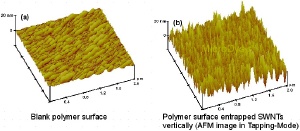Jul 30 2009
MicroDysis develops and markets biomedical and environmental devices and systems that use embedded carbon nanotubes to solve a wide variety of real-world problems. The Company's patented micro-molding fabrication and nanotube assembly techniques are able to embed vertically oriented carbon nanotubes into a polymer matrix. Recently, MicroDysis demonstrated this technique to entrap single-walled carbon nanotubes (SWNTs) onto a polymer surface, such as elastomer or silicone rubber, and plastics. This approach increases the functionalized surface of a device by 10,000 times and provides an ideal matrix for attaching molecular probes and other chemically active absorbers for maximum detection sensitivity. MicroDysis further developed an 8-well strip microplate with the bottom surface entrapped SWNTs for pharmaceutical and biomedical applications.

Assembly of carbon nanotubes from as-grown randomly tangled states into well-ordered and uniform manner has attracted considerable attentions worldwide due to specific properties of the carbon nanotubes and its importance for chemical, biomedical and engineering applications. Carbon nanotubes show their superior properties for immobilizing biomolecules with a three-dimensional nano-architecture and highly dense functional groups on the surfaces. For sensors, biochips, and many other applications, the well-ordered and functionalized carbon nanotubes are greatly desirable. However, the creation of properly oriented nanotubes remains a big challenge due to their fragility and that technology has not been broadly commercialized.
Atomic Force Microscope (AFM ) images (in Tapping-Mode) shows that SWNTs are vertically assembled on polymer surface. The average height of the entrapped SWNTs is around 40 nm. The nanotubular features of the nanotubes on the surface significantly enhance the surface area to about 10,000 times greater than a blank surface. With the functionalized surface feature (-COOH groups) on the nanotubes, this technique will find broad wide application in immobilizing sensing molecules for DNA assays, protein analysis, and chemical compound and ion detection.
Advantages of this technique:
1. Vertical assembled single-walled carbon nanotubes on polymer matrix.
2. Surface area increased about 10,000 times.
3. Highly dense-COOH groups for chemically binding sensing molecules.
4. Versatile sensing platform.
MicroDysis designs and manufactures a wide variety of microfluidic devices and instrumentation. The Company focuses on enhancing test sensitivity using its patented micro-fabrication technology for embedding functionalized carbon nanotubes onto surfaces of channels and micro-wells.